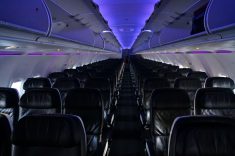 Despite the global economic downturn, airlines have been updating their fleets with the latest and most efficient aircraft from major airline manufacturers such as Boeing and Airbus. Norwegian Air Service (operating as Norwegian), the airline that rose from the ashes of Busy Bee, has signed contracts worth $22 billion for some 222 new aircraft from Boeing and Airbus. This is a significant order for an airline with a current fleet of 74 aircraft.
Despite the global economic downturn, airlines have been updating their fleets with the latest and most efficient aircraft from major airline manufacturers such as Boeing and Airbus. Norwegian Air Service (operating as Norwegian), the airline that rose from the ashes of Busy Bee, has signed contracts worth $22 billion for some 222 new aircraft from Boeing and Airbus. This is a significant order for an airline with a current fleet of 74 aircraft.
With the global economy in turmoil, orders such as this might at first seem overly ambitious. Bjorn Kjos, the CEO and largest shareholder in Norwegian, insists that purchasing new aircraft is one of the best ways to compete in an already overcrowded, highly competitive industry. According to him, new aircraft are designed and built with economy and passenger comfort in mind, to reduce operating expenses and to foster vital customer loyalty. Furthermore, placing significant advance orders limits timely supply to competitors.
However, it is not just the economic advantages of ordering new aircraft that keeps Mr Kjos motivated. It is also the need to compete with the emerging low-cost long-haul market currently dominated by the low cost Asian carriers.
European legacy and low cost carriers rely on competition restrictions to prevent Asian airlines such as Air Asia from operating directly in their home market. Mr Kjos considers this to be a pointless strategy and predicts that while nine out of 10 passengers flying between Europe and Asia are Europeans, this trend will be reversed in a decade. Politicians in Europe will not be able to ignore the huge potential for mass tourism, which in turn will create new and much needed jobs.
Politicians cannot afford to say no to global Open Skies agreements. While low-cost long-haul operations are far too expensive today , Norwegian is pushing ahead with their long haul ambitions and developing cost-cutting strategies to make their ambition reality.
Norwegian statistics:
Scandinavia’s second largest airline
The third largest low-cost airline in Europe
10th largest low-cost carrier in the world
Source: bbc.co.uk


 Despite the global economic downturn, airlines have been updating their fleets with the latest and most efficient aircraft from major airline manufacturers such as Boeing and Airbus. Norwegian Air Service (operating as Norwegian), the airline that rose from the ashes of Busy Bee, has signed contracts worth $22 billion for some 222 new aircraft from Boeing and Airbus. This is a significant order for an airline with a current fleet of 74 aircraft.
Despite the global economic downturn, airlines have been updating their fleets with the latest and most efficient aircraft from major airline manufacturers such as Boeing and Airbus. Norwegian Air Service (operating as Norwegian), the airline that rose from the ashes of Busy Bee, has signed contracts worth $22 billion for some 222 new aircraft from Boeing and Airbus. This is a significant order for an airline with a current fleet of 74 aircraft.

